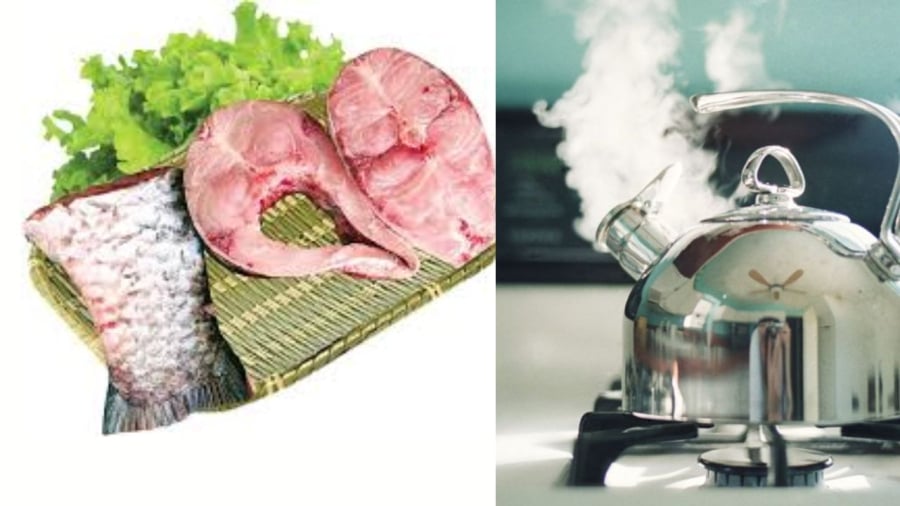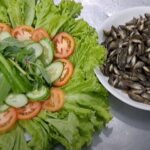There are two popular variations of fish soup: sour soup and vegetable soup. When making sour soup, depending on the region, ingredients such as fermented rice, turmeric, pineapple, green mango, or star fruit are used, along with herbs like Chinese celery, ngổ (a type of aquatic plant), cucumber, radish, and pickled vegetables.
Fish soup is a common dish in family meals throughout Vietnam, from the North to the South, although the preparation methods vary. In some regions, turmeric and Chinese celery are used as distinctive spices, while others prefer to cook with pineapple, ngổ, green onions, or bitter melon. Despite these differences, there are some general principles to follow to ensure the fish doesn’t taste muddy and has a sweet flavor.
Preparation techniques to prevent a muddy taste
Firstly, to avoid a muddy taste, choose fresh, high-quality fish that hasn’t been intensively farmed. Clean the fish thoroughly by scaling, rubbing with salt to remove slime and any muddy taste, and scraping away the dirty black membrane inside the belly.
To ensure the fish is thoroughly cleaned, wash it with salted water or a mixture of ginger-infused water, which helps reduce the muddy taste and effectively removes blood and the black membrane.

Proper fish cleaning is essential
Always use boiling water, never cold water, when cooking fish soup
Using boiling water is crucial when making fish soup. Adding the fish to boiling water causes the flesh to contract quickly, and the skin cooks rapidly, reducing the release of amino acids and thus preventing a muddy taste. Additionally, the rapid contraction of the flesh helps retain the sweetness of the fish, ensuring it doesn’t become dry and crumbly.
Many people buy fresh, high-quality fish from the market, only to end up with a muddy-tasting dish because they fail to follow this step. If you cook the fish in cold water, the slow cooking process allows more amino acids to be released, making the soup taste muddier. Moreover, adding cold water to a boiling pot of fish soup intensifies the muddy flavor.
Simmer the fish soup over medium heat
After bringing the soup to a boil, add the fish, and once the water returns to a boil, reduce the heat to a gentle simmer. If the soup boils vigorously, it will release more amino acids, resulting in a muddier taste and causing the fish flesh to disintegrate, becoming dry and less sweet.

Always use boiling water when adding liquid to the fish soup
Keep the lid off the pot to prevent a muddy taste and ensure clear broth
Leaving the lid off the pot when the soup is boiling allows the amino acids to dissipate with the steam, reducing the muddy taste. If you cover the pot, the soup tends to become cloudy, and when you open the lid, the muddy taste is more pronounced. The condensation that forms on the lid drips back into the soup, creating a continuous cycle that intensifies the muddy flavor. Additionally, if you’re cooking vegetable soup with the lid on, the vegetables may turn reddish and lose their aesthetic appeal.
The importance of spices in fish soup
The spices used in fish soup vary depending on whether it’s a sour soup or a vegetable soup, and they also differ by region and family preferences. Some common spices include Chinese celery, green onions, turmeric, and ngổ. If you’re making a vegetable fish soup, ginger and green onions are a must, while sour soup requires a balance of sour and spicy flavors. In Southern Vietnam, fish soup often includes ngổ and pineapple, while the famous sour soup in Hue uses sour leaves to add a unique sourness and neutralize any muddy taste.
Spices not only enhance the flavor of the soup but also help neutralize the muddy taste and add a delightful aroma. For families who enjoy spicy food, adding a few slices of chili peppers not only boosts the flavor but also helps mask any remaining muddy notes.
Therefore, when preparing fish soup, ensure you have a variety of spices on hand to make the dish more enticing and delicious.

Don’t forget to add a variety of spices to your fish soup
Should you fry the fish before cooking the soup?
There is some debate among cooks about whether frying the fish before adding it to the soup helps neutralize the muddy taste. Some argue that frying is necessary to prevent a muddy taste, while others believe it compromises the freshness of the dish. In reality, whether the fish tastes muddy or not depends primarily on the steps outlined above, and frying has a minimal impact on the muddy flavor.
Even if you fry the fish, adding cold water to the boiling soup or pouring boiling soup over fried fish can still result in a muddy taste. Therefore, the decision to fry or not fry the fish depends on personal and family preferences. If you don’t want the fried fish taste in your soup, simply follow the tips mentioned above, and you’ll end up with a delicious, non-muddy fish soup.
Fish soup is a simple yet beloved dish in many households, and it’s also nutritious. Feel free to experiment with different cooking methods, spices, and regional variations to create diverse and enjoyable meals for your family. Especially with sour fish soup, each time you cook it, you can try a different regional style, and it will taste like a brand-new dish!



































